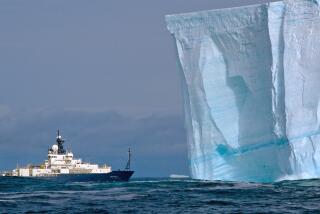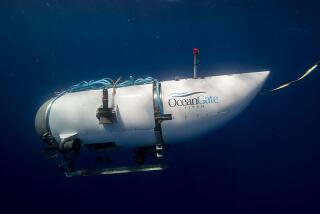She Plans to Set Out Alone Into No-Woman’s Land
- Share via
When Pam Flowers leaves Canada’s Ward Hunt Island with her small team of dogs Monday, she’ll be trying to make history as well as a statement about the role of women in polar expeditions.
The 41-year-old respiratory therapist from Willow, Alaska, a small town roughly 70 miles north of Anchorage, hopes to arrive at the North Pole in about 55 days, becoming the first women to get there alone by means of surface travel.
“(Men) always tell me I can’t do it,” she said by telephone from her base camp in Resolute, on Cornwallis Island in the Northwest Territories. “Women have traditionally been excluded from polar expeditions and I hope to prove that if one woman can do it, then women have earned the right to be included.”
From Resolute, Flowers will fly north to Ward Hunt Island to begin her journey to the top of the world.
Two men have accomplished what Flowers hopes to. In 1978, Naomi Uemura of Japan made it to the North Pole with a sled-dog team, and in 1986 Frenchman Jean Louis Etienne skied there.
Flowers hopes to cover the 475 miles in time for a summit meeting in the literal sense, with a joint Soviet-Canadian expedition that got underway Thursday.
Four Canadians and nine Soviets began their voyage--the first attempt at a transcontinental crossing of the pole--on the snowy fields of ice floes that link the northernmost tip of the archipelago known as Severnaya Zemlya--which means Northern Land--with the polar ice cap.
According to Flowers, the parties intend to meet May 1, give or take a day or two, to exchange greetings, flags and information.
What makes Flowers’ trek difficult, besides such obvious reasons as blinding blizzards and temperatures reaching 70 degrees below zero, is the geographic makeup of her route.
“It’s all over frozen ocean,” she said. “A big sheet of ice that’s constantly in motion under you. (The ocean) has many currents, so sometimes the ice will fracture and open up. You have to either figure a way around it or over it. If you can’t do that you have to wait for it to freeze up again.
“Given those obstacles, I’d say it’s more like 800 or 900 miles.”
Still somewhat short of funds, Flowers, who originally planned on receiving four air drops of supplies along the way, might have to forgo that subsidy, but said the show must go on.
“I feel like I can (still) make it because I’ve been in the Arctic for up to six weeks at a time and have carried this much weight (650 pounds at the start) on my sled before. I’m confident, but I will just have to suffer a bit more.”
Flowers, who lives by herself in a remote cabin with no electricity, running water or telephone, is used to being alone in the wilderness and is indeed an experienced Arctic explorer, having successfully accomplished two solo 1,000-mile trips along the west Alaska coast--one with a broken arm--and one solo 450-mile trip, also along the coast.
This particular trip will be more difficult for the 5-foot, 105-pound Flowers, whose sled will be pulled by only three dogs, all Alaskan Huskies weighing from 65 to 85 pounds. She will walk.
“People say going to the North Pole is like climbing Mt. Everest horizontally,” she said. “You go up and down and around so much, and it’s so much colder. . . . Everything’s a bit more severe.”
When asked if she is afraid, she answered with a resounding no.
“It won’t even enter my mind,” she said. “I’ve been training for a long time, going further and further into the Arctic, to get accustomed to openness and barrenness and the high winds.
Asked about the possibility of becoming a meal for a polar bear, she answered: “They eat seals and there are plenty of them .”
Last year, however, a small female polar bear demolished Flowers’ camp in a two-hour fit, all the while ignoring her.
“Just property damage,” she said, adding that there are other animals that also require a measure of concern.
On her second solo trip trip in 1986, Flowers was attacked on more than one occasion by rabid foxes, one at the starting point of her 1,000-mile trip, at Prudhoe Bay, Alaska. The fox was shot by a worker at the oil facility there before it could bite Flowers.
“The next day, I was alone (on her way) and another fox charged across the tundra, attacked and bit five of my dogs (all of which survived). I had this small pistol but couldn’t get a clear shot, so I took a piece of dried fish and threw it and fox ran over to see what it was. Then it turned and ran toward me and I shot her. . . It was the only animal I have ever killed.”
The pistol accompanies her on all such excursions.
Her primary concern, she says, is with the weather and conditions on the ice, which at times can be extremely dangerous.
“Once a storm started coming toward us. I was out on the ice, the storm shifted and was blowing toward the sea, separating the ice and breaking it up. First my lead dog went in the water. I fished him out and I was trying to get across to land because it was a very bad circumstance. The ice was breaking up really fast. I was throwing dogs across one after another (10 of them) when the last dog pulled me off my feet. My legs went into water but I made it out and dried off as best I could.”
Should an emergency occur that requires assistance, Flowers will be somewhat prepared to get word out. She will be armed with an emergency locater that sends a distress signal via satellite to a ground station in Canada. In 1984, while on an endurance exercise across the Alaska tundra, such a situation arose.
Flowers became ill with a virus and ran into a fierce blizzard. Feeling that she could go no farther, she pushed the button and was rescued within 24 hours.
Flowers also has a radio and a satellite navigator, “a small beacon-like thing that sits on my sled,” to keep in touch with the Canada-Soviet entourage.
“It’s kind of amazing what these things can do,” she said, using a term that might well describe her own courageous act.
More to Read
Sign up for The Wild
We’ll help you find the best places to hike, bike and run, as well as the perfect silent spots for meditation and yoga.
You may occasionally receive promotional content from the Los Angeles Times.






